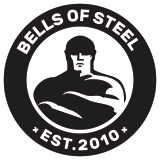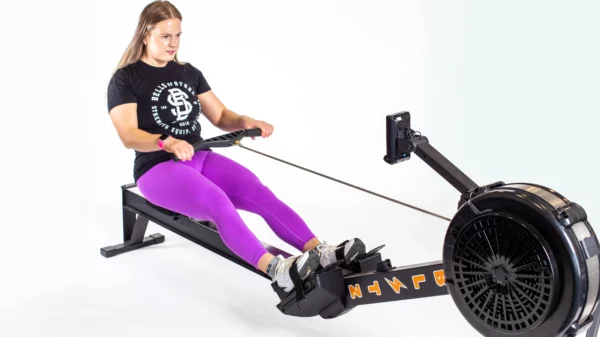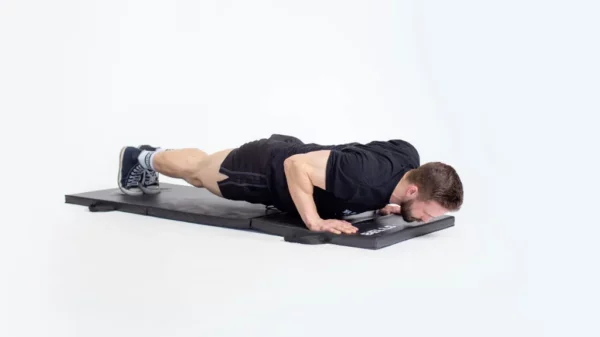The deadlift is a staple exercise for anyone looking to build a bigger and stronger body. Not only that, when executed and implemented appropriately, it can prevent injury and even improve your mobility. So, if you’re committed to becoming a more physically robust individual, the deadlift is an exercise you don’t want to forego.
But since deadlifts stimulate multiple muscles along the back side of the body, where does it fit within your training regimen? Is it a leg day exercise or a back day exercise? Is it all just a matter of preference?
The truth of the matter is that deadlifts are both a leg exercise and a back exercise; the human body is designed to move in patterns, which requires coordinated contraction of multiple muscles to achieve these patterns.
The conventional deadlift is a combination of two movement patterns:
- a squatting pattern (a knee-dominant movement)
- a hip-hinging pattern (a hip-dominant movement)
So naturally, deadlifts will stimulate multiple muscle groups, making the exercise a candidate for being performed on different training days.
Let’s look at all of this in greater detail. By the end of this article, you’ll have the insight required to know where deadlifts should go within your training regimen.
Muscles worked with Deadlifts
The deadlift is known as a compound exercise, which means it requires movement from multiple joints within the body. This, in turn, targets multiple muscles within the body every time you perform the movement. Muscles are what move joints, so an exercise that predominately involves extending (straightening) the knees and hips will require muscles crossing over these joints to produce the force necessary to complete the movement.
Special note: What follows directly below pertains to the conventional barbell deadlift. Muscle recruitment patterns will change slightly with different deadlift variations (trap bar deadlifts, sumo deadlifts, etc.). A brief rundown on muscle activation with these deadlifting variations will be discussed after discussing the conventional deadlift.
Leg muscles worked with Conventional Deadlifts
For the conventional deadlift, the movement will stimulate the thigh and hip muscles. In particular, these muscle groups include:
- The quadriceps muscles
- The hamstrings muscles
- The gluteal muscles (gluteus maximus, in particular)
The quadriceps muscles will work to straighten the knees, while the hamstrings and gluteus maximus will work to straighten the hip, which collectively results in the body moving to a tall, upright position (the completion of the deadlift).
Back muscles worked with Conventional Deadlifts
The erector spinae muscles are a group of back muscles that play a prominent role when performing the deadlift. They help to keep the torso from collapsing forwards and to keep the lumbar spine (the lower portion of your spine) from rounding during the movement. These muscles run further up the back than most lifters realize, but for the sake of this article, we can think of them mainly as lower back muscles.
The individual muscles aren’t overly important to know, but in case you’re wondering, the erector spinae includes:
- The iliocostalis
- The longissimus
- The spinalis
Random tip: When learning these muscles years ago, I always remembered them as the “I Love Spaghetti” muscles (each letter there referring to the first letter used to spell the name of the muscle). That’s a free tip for you, in case you want to become an anatomy nerd like me.
While these muscles aren’t the primary muscle group involved in completing the deadlift, they still contribute to a noticeable extent, especially with keeping the torso at an ideal angle and preventing the lower back from rounding throughout the movement.
Upper back involvement
While not a primary muscle involved with performing the deadlift, the trapezius muscle is still worth mentioning. This is the large middle and upper back muscle often called the traps or trap muscle.
The upper fibers of the trap muscle (the fibers along the top of your shoulders and the back of your neck) play an important role in preventing your shoulders and arms from being pulled downwards when holding onto the barbell.
As such, your upper traps undergo a high amount of sustained effort during the deadlift. This is why lifters often feel sore in their mid-upper back region after a heavy deadlifting session and why the case is often made for deadlifts being a back exercise. Indeed, the traps contribute to the deadlift, just not as a primary mover of the barbell.
Muscle differences with Deadlift variations
While an entire blog post could be written on how muscle activation patterns change with each type of deadlift variation, that’s not the intent of this article. And thankfully, the changes are on the mild side; the muscle groups responsible for each variation are quite similar and likely won’t play a central role in determining whether you should perform your deadlifts on leg day or back day.
Let’s quickly run through three common deadlift variations and what you may want to consider when determining what training day they should fall on.
Romanian Deadlifts

Compared to the conventional deadlift, the main difference with Romanian deadlifts (RDL) is the absence of knee movement and the resultant heavy emphasis on hip movement (through the hip-hinge pattern).
The result is less quadriceps recruitment during the movement and a greater emphasis on muscles that extend the hip and torso. These muscles are located on the back side of the body and include the following:
- The hamstring muscles
- The gluteus maximus
- The erector spinae muscles.
If you’re trying to figure out where to place these deadlifts into your regimen, they’ll very likely suit a leg day, but it’s easily justifiable to perform them on back day as well.
Some lifters enjoy performing RDLs more toward the end of a training session to challenge their erector spinae muscles. If you’re using RDLs for this particular exercise, however, it may be worth performing barbell good mornings instead since they place a greater emphasis on the low back muscles.
Trap bar (hex bar) Deadlifts

When looking at muscle recruitment patterns, the main feature of trap bar deadlifts is the greater muscle activation that comes from the quadriceps muscles. This is because the weight is directly in line with the lifter rather than slightly in front. The result is more of a direct involvement from the quadriceps muscles.
Additionally, since the torso remains in more of an upright position throughout the entire lift, the erector spinae muscles undergo less exertion than the conventional deadlift (which places the torso at more of a forward angle).
As such, trap bar deadlifts are an ideal candidate for leg day rather than back day.
Sumo Deadlifts

The sumo deadlift involves using a stance width greater than the width of the lifter’s shoulders. It places a greater emphasis on the hip and adductor (inner thigh) muscles while keeping the torso more upright. With the torso remaining upright, less emphasis is placed on the erector spinae muscles.
Based on the increased demand on the hip muscles and a decreased demand on the low back muscles, sumo deadlifts are likely best left within the “leg day” category. To be clear, the low back muscles are still working but with less intensity due to the upright torso positioning utilized throughout the lift.
Back day or Leg day: Programming Considerations with Deadlifts
There’s no universal rule stating that deadlifts must be performed on a particular type of training day. Now, based on your specific training goals, there may be poor choices for when you perform them, but ultimately the decision regarding which training day is most ideal for deadlifting must take into account several factors.
These factors can include the following:
- The type of training split your program utilizes (upper body day, pull day, full body day, etc.)
- The type of deadlift you’re performing (conventional, trap bar, sumo, etc.)
- The overall deadlifting volume you’re performing (loads utilized, sets, reps, and overall intensity).
- The intention of the deadlift (increasing strength, improving range of motion, practicing technique, etc.)
Training Split Considerations
The type of training split your lifting regimen utilizes can be a significant factor in when you may want to put deadlifts into your session. If you’re unaware, a training split simply refers to how your strength training program divides your entire workout program into individual training sessions.
Training splits can typically be divided into two different categories:
- Muscle-based training sessions
- Movement pattern-based training sessions
Muscle-based training splits
If your program splits up your training based on body parts, you’ll likely want to keep your deadlifts confined to leg day (or lower body day). The amount of muscular recruitment to the quadriceps, hamstrings and gluteus maximus is very high in relation to the amount of work performed by the spinal erector muscles.
Movement-based training splits
Movement-based training splits are typically divided into push-based and pull-based sessions. This refers to whether the body is pushing a resistance load or pulling a load.
If your program splits your training into movement patterns (push day vs pull day), you’ll need to keep your deadlifts to pull day. It’s predominately a pulling-based exercise, so there’s not much wiggle room here.
Universal Deadlifting Considerations
Regardless of the type of deadlift you want to perform or the type of training split you’re using, here are some universal considerations that you may want to employ with your training:
- Consider performing your deadlifts at the start of your training session; since they are a more technically based movement and typically performed with higher loads, you’ll want to perform them when you’re neither physically nor mentally tired – either of which can lead to sloppy technique, ineffective training, and potential injury.
- Regardless of deadlift type, make sure that both your legs and your back are prepped and warmed up before performing your working sets. You may want to also consider performing “working warmup” sets with just the barbell, where you perform the deadlift without any added weight. This is often termed “greasing the chain” or “grooving the pattern” and can be immensely helpful for preparing your body (and mind) for your upcoming working deadlifts.
- Keep your deadlifts under control at all times; if you feel your control or technique is off, take the time to figure out where things are going wrong and how they can be cleaned up. It’s hard to train when your back or hips are lit up from poor technique.
Final thoughts
If you’re serious about strength training, incorporating deadlifts (if appropriate for your needs and abilities) can yield significant training benefits; you’ll target leg and back muscles simultaneously, making for highly effective muscle stimulation and overall strength and muscle gains.
Don’t take a strictly dogmatic approach to when you should perform deadlifts; you’ve got options for whether you perform deadlifts on leg day or back day, much of which will depend on your type of training split and what you’re hoping to achieve with your deadlifts.
This is a guest post by Jim Wittstrom. Jim is a physiotherapist and strength & conditioning specialist currently practicing in Calgary, Alberta, Canada. His passion is to help others overcome their physical pain and come back stronger than before. For more great info, you can find him on Strength Resurgence.








